| Physics 202 |
Intro to Astronomy: Lecture #25
|
Prof. Dale E. Gary
NJIT
|
Dark Matter
The Mystery of Dark Matter
Do the dark matter tutorial to find out how we determine the existence and distribution of dark matter in galaxies.
You will learn that the orbital speed of an object around a central mass depends
on
-
its distance from the central
mass, and
-
the total
mass enclosed within its orbit.
For objects orbiting a concentrated
mass (e.g. the planets orbiting the Sun), the orbital speed goes down as
we go outward from the Sun because the distance is increasing, but the
total mass enclosed (essentially the Sun's mass) is constant.
In the case of a galaxy,
the total mass enclosed grows with distance, because more of the galaxy's
mass is inside the orbit, and this trend continues until we go outside
the galaxy. For objects outside of a galaxy, we would expect the
orbital speed to drop with distance, just as it does for planets in the
solar system.
We
can use the measured orbital speeds to "weigh" the amount of mass in galaxies
as a function of radius. When we do this, we find the surprising
result that even though the visible emission (either starlight or radio
emission from hydrogen clouds) is falling off at the edge of galaxies,
the orbital speeds keep steady or even goes
up, indicating that the enclosed mass keeps increasing. Here is the rotation curve for our galaxy:
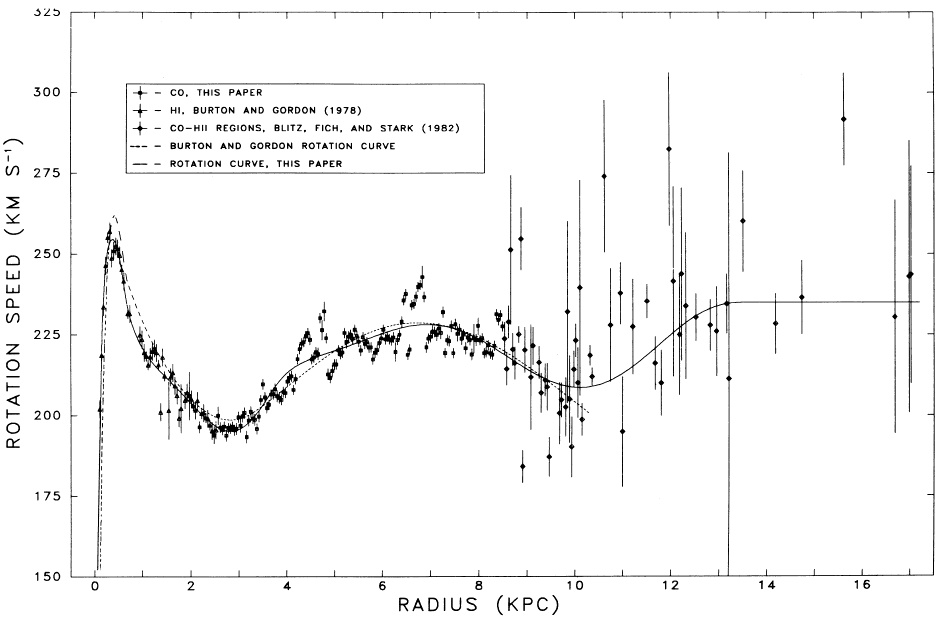
The rotation curve of the
Milky Way Galaxy. The IAU standard values of Ro
= 8.5 kpc and Qo
= 220 km/s have been assumed.
(Figure reproduced from
Clemens (1985), Ap. J. 295, 422.
You can see from the above
figure that the central part of the galaxy contains a lot of mass in the
central bulge, and as we go away from the bulge the orbital speeds go down
about as we would expect. This is shown by the plot below.
If we model a disk distribution, that can explain part of the increase
in orbital speeds at around 6 kpc, but not all of it. And as we go
farther out from the center, the discrepancy keeps growing. This
"missing mass" is called the dark matter halo.
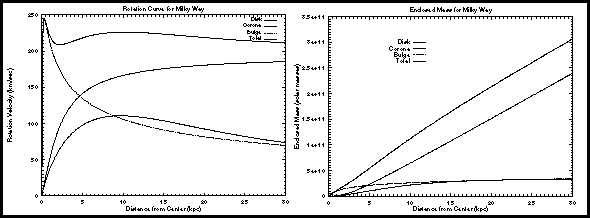
The plot on the left shows
the Total rotation curve for our galaxy, made up of contributions
from the Bulge, the Disk, and the Corona. The
plot on the right shows the Interior Mass, M(R), as a function
of radius (called the enclosed mass here). Both the disk and
the bulge reach a constant interior mass, meaning that at a radius of 25
kpc or so, all of the mass is inside this radius, and the rotation curve
for these components drops approximately as R-1/2.
The corona mass (dark matter), however, appears to continue to rise with
radius! (This image is from Nick Strobel's web
site.)
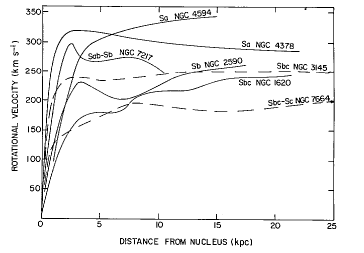
A series of rotation
curves for spiral galaxies. (Figure from Rubin, Ford, and Thonnard (1978),
Ap. J. Lett., 225, L107.)
Is it just our galaxy that shows
this peculiarity? The plot above shows that other spiral galaxies
also show the same basic pattern -- it appears that all galaxies have dark
matter halos. If we do the same measurement with elliptical galaxies,
we see the same effect.
The discrepancy is characterized
by the mass-to-light ratio. We
can easily measure the total visible luminosity of a galaxy, and its distribution
with radius. If we give this amount in units of the solar luminosity
Lsun, for example, we find
that our galaxy has a luminosity of about 100 billion Lsun.
This is why we have claimed up to now that the Milky Way galaxy contains
100 billion stars. If we assume that 1 solar mass creates 1 solar
luminosity, then 100 billion solar luminosities would be created by 100
billion solar masses, so we would expect that the mass-to-light ratio of
the galaxy would be about 100 billion Msun /
100 billion Lsun = 1 Msun
/ Lsun.
Instead, we routinely find that the mass-to-light ratio is more like 10
Msun / Lsun,
so 90% of our galaxy's mass must not be luminous -- i.e. is in the form
of dark matter.
Dark Matter in Clusters
As if the situation
with individual galaxies was not bad enough, we have two other kinds of
evidence that the problem gets even worse on the scale of clusters of galaxies.
Recall that last time we mentioned that galaxies occur in clusters like
the one below.
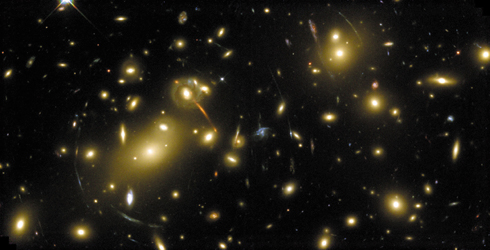
In these clusters we can
measure the speeds of the individual galaxies, which gives one estimate of the mass to light ration. And we can measure the gravitational
lensing (bending of light by the gravity of the cluster), which creates
the arcs of light seen in the above picture, and gives an independent estimate of the mass to light ratio.
Speeds of Galaxies in
Clusters
In the 1930's, an astronomer
named Fritz Zwicky measured the dispersion of
speeds of galaxies in clusters by measuring their doppler shifts.
Most or all of the galaxies will be redshifted, of course, due to the recession
speed of the entire cluster, but some will be more redshifted and others
less redshifted. The dispersion of speeds means the amount of variation
in these redshifted speeds, which is a measure of the random motions of
the galaxies. Assuming that the galaxies in clusters are gravitationally
bound (that is, they are stably orbiting their common center of mass, and
not flying away from each other) then their orbital motions will appear
random, but must be less than some value (basically their escape speed).
Any galaxy in the cluster that is moving too fast will not be bound, and
will fly away into space. But how fast is too fast? It depends
on the total mass of the cluster. The higher the mass, the higher
the velocities of bound galaxies are allowed to be.
To turn the argument around,
the maximum speed of the galaxies gives a measure of the total mass of
the cluster. Again, we can measure the total luminosity of the cluster
and compare it to the total mass of the cluster inferred from the dispersion
of speeds, and again we find that there is far more mass than would be
indicated by the luminosity. In fact the mass-to-light ratios of
clusters generally exceed 100 Msun /
Lsun.
Gravitational Lensing
Both the orbital velocity
of stars and gas in galaxies and the dispersion of speeds in clusters relies
on Newton's Laws. There is another way to determine the mass in clusters
of galaxies using Einstein's General Relativity, which is completely independent
of orbital motions. As we noted before, light is bent when it passes
near a large mass, and the higher the mass the greater the bending of the
light. A
lens you can play with. We can use this bending to determine
the mass of the cluster as follows:
-
find multiple images of a single
galaxy created by the gravitational lensing (the bluish features in the
above picture). (How do we know they are multiple images of a single galaxy?)
-
determine the angular distance
to the multiple images as seen in the picture.
-
determine the distance to the
distorted galaxy from its recession velocity and Hubble's Law
-
determine the distance to the
cluster in the same way, using Hubble's Law
-
use Einstein's theory of general
relativity to relate the angular separation to the mass of the cluster.
When this is done carefully,
we find exactly the same result as before -- the universe contains as much
as 10-100 times more dark matter than ordinary luminous matter!
What is Dark Matter?
Dark matter is mysterious,
but it need not be exotic. One possibility is that it is simply small
but dense objects of ordinary matter that are invisible. Examples
are brown dwarfs (too small to be stars, and too faint to detect in the
galactic halo), black dwarfs (old white dwarfs that have cooled off and
no longer emit much light), black holes, or perhaps some other form of
ordinary matter. Such matter is called baryonic
matter, because it is made up of baryons (protons and neutrons).
Astronomers have whimsically termed such objects as MACHOs
(MAssive Compact Halo Objects). Since such objects are too
faint to see, we have to use other means to detect them. One way
is to look for tiny gravitational lensing events as they pass in front
of distance light sources. In fact, such tiny lensing events have
been seen, but not in the huge numbers that would be required to account
for the missing matter.
A more exotic possibility
is that the dark matter is not in the form of ordinary matter, but rather
is made of some kind of sub-atomic particle that we have not yet discovered.
Such particles would have to have lots of mass, but not interact with light.
Astronomers have (again whimsically) termed such objects as WIMPs
(Weakly Interacting Massive Particles).
We have already met one kind of weakly interacting particle -- the neutrino.
But neutrinos, which do exist in huge numbers, have two problems.
One is that they do not have enough mass (although they may contribute
a small amount to dark matter outside galaxies), and the other is that
they would not collect around galaxy clusters. They are so energetic
that they zoom around the universe anywhere they want to go, and barely
feel the mass centers in clusters of galaxies. Instead, we need some
kind of particle that is more massive than neutrinos, and that is slower
so that it can collect around mass centers. So far we have not discovered
such particles, but perhaps someday particle experiments will identify
them.
Meanwhile, we are stuck with
no certain explanation, and not too many clues. One important clue
that seems to favor WIMPs over MACHOs is the distribution of the dark matter.
Ordinary baryonic matter has collected in the centers of mass concentrations
like galaxies and clusters of galaxies, so whatever dark matter is, it
must resist clumping on these scales. WIMPs fill this expectation
nicely, since they would have been born rather hot (high speed) in the
Big Bang. Baryons were also hot, but they interact with light and
so produce radiation that allows them to shed their energy, cool, and collect
into galaxies, etc. WIMPs, on the other hand, have no way to lose
energy, so they would remain more loosely clustered in galaxy halos.
Superclusters and Large Scale
Structure
In the very first
lecture we discussed the fact that our galaxy is part of the Local
Group of galaxies, comprising the Milky Way Galaxy, the Andromeda
Galaxy, the Magellanic Clouds, and some 20 others. We also said that
the Local Group was part of a larger collection of galaxies called the
Local Supercluster. As we look
out into the night sky, we see huge numbers of galaxies in all directions,
and from their recession velocities and Hubble's Law we can determine their
distance. From this we can build up a 3-dimensional map of galaxy
locations. What we find is that galaxies are not uniformly distributed
in space, but rather form these huge structures called superclusters, held
together by gravity.
By measuring the peculiar
velocities of galaxies (their velocities after subtracting their recessional
velocity), we find that they seem to be gathering into concentrations of
mass. Here is Figure 21.13 from the text The Cosmic Perspective, which plots the peculiar
velocities of galaxies near ours (the Milky Way Galaxy is in the center).
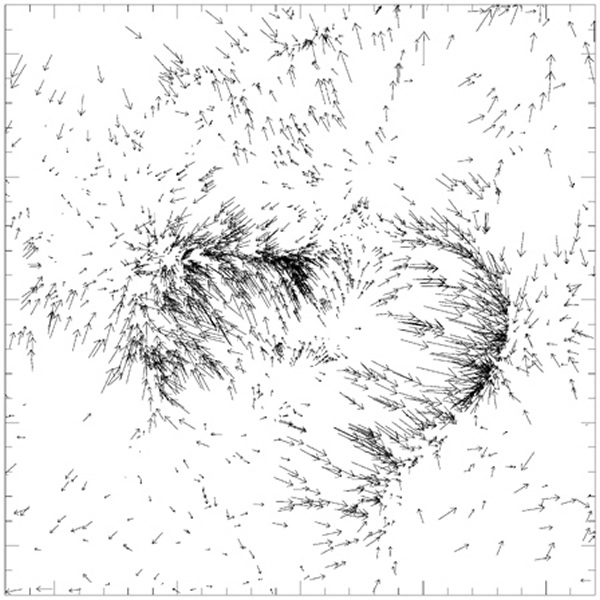
Fig 21.13 from the Cosmic Perspective, by Bennet, Donahue, Schneider & Voit, Addison Wesley (1998)
The galaxies appear to be moving
"downhill" into several concentrations of mass. When we look farther
out into the universe, the large scale structure of the universe becomes
apparent. There are regions of superclusters, and other regions called
voids, which contain no galaxies at
all. The overall structure appears like a sponge, with spherical
voids separated by membranes of mass.
Fig
21.14a
Fig
21.14b
Fig
21.16a Looking into the past.
To explore how this structure
was created, we can start with the Big Bang and imagine some tiny fluctuations
in the early universe. These fluctuations would have been slightly
cooler, and allowed mass to collect and collapse, which further cooled
the region (by radiating excess energy away), so that the areas where matter
collects gets more concentrated. So the large scale structure that
we see shows us what the early universe must have been like. We can
run simulations and see what initial conditions
are needed to make the universe appear as it does today.
How Much Matter Is There?
The fate of the
universe is tied up in this question. Will the universe continue
to expand forever, or will it eventually stop expanding and start to collapse
(to end in the "Big Crunch," which
is the opposite of the Big Bang)? The answer to this question depends
on the density of the universe. There is a critical
density at which the universe will slow down but not stop expanding
-- just balancing on the edge between expanding forever and collapsing.
If the universe is less than the critical density, then it will continue
to expand forever (leading to an open universe),
while if it is more that the critical density it will eventually stop expanding
(leading to a closed universe).
At exactly the critical density, the universe will keep expanding forever,
but will go more and more slowly so that it eventually would stop after
an infinite time has passed. This is called a flat
universe.
Note that each of these scenarios
indicates that the expansion should be slowing down, even if it never comes
to a stop. When we do measurements designed to determine whether
our universe is open or closed, it always seems to indicate that we are
very very close to a flat universe. That means that our universe
is close to the critical density. Yet, when we count up all of the
matter, we find that it is not enough to make the universe flat, even if
we include dark matter. In fact, if we call the critical density
rcrit,
then the matter density appears to be around 0.3 rcrit.
Yet we should be able to tell if the universe were so open (so far below
the critical density), and our observations do not show it. For many
years we have had this apparent contradiction -- the universe appears to
be flat, but there is too little matter (including dark matter) to make
it so.
Recently, things have gotten
even stranger. By measuring the most distant supernovae, which we
believe to be standard candles, it appears that the universe was once expanding
more slowly that it does now. In other words, the
rate of expansion appears to be accelerating! Astronomers
are now toying with the idea that there is an exotic form of energy that
is pushing space apart -- a kind of negative gravity. This form of
energy is called dark energy, and it
is possible that, if there is enough dark energy, it might explain why
the universe appears flat.
Next time (our last lecture)
we will look into the question of cosmology, the Big Bang and the beginning
of the universe.




